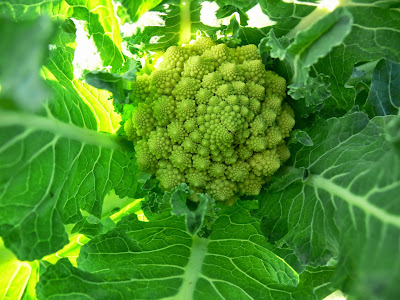Some vegetables are born showoffs. It may be because they're loud (super-sized pumpkins), blousy (curly kale) or just plain beautiful. The Romanesco cauliflower fits into the latter category and, to the uninitiated, the precision of its intricate, geometric heads, or curds, really does earn it admiration.
The Romanesco is a member of the cabbage family. For the sake of this article and to keep things 'tidy' I've called it a cauliflower. But, the truth is, it's in a class of its own – neither cauliflower nor broccoli but somewhere in-between. Hailing from northern Italy, this approximately 500-year-old brassica has all the hallmarks of Italian design. It's suave. It's sophisticated. And it promises impeccably good taste!
Sow from spring to midsummer to give a succession of curds. Like all brassicas, Romanesco cauliflower is best started off in a fertile seedbed or in modules of seed compost/potting mix. I prefer using generous-sized module trays because this produces really solid plants, while minimising root disturbance at planting out time. Aim for a cell size that's at least 5cm (2in) across. Start your earliest seedlings off under the protection of an unheated greenhouse or cold frame.
Sow the seeds 1cm (0.5in) deep, sowing two to three seeds per cell. They can be thinned out to leave the strongest seedling once they have all germinated. Romanesco cauliflowers planted outsideGiven a little warmth they may pop up in as little as four days, but allow up to two weeks. The seeds need a minimum temperature of 10°C/50°F to germinate but once they're up the daytime temperature can happily hover around 7°C/45°F with no negative impacts on the seedlings.
Young plants that have been started off under cover will need to be hardened off before they are planted out. This will stop them from sulking at the sudden transition from relative warmth to cold. Hardening off Romanesco Cauliflower as a young plantis especially important in temperate regions or in a slow season where spring is late in arriving. To harden plants off, leave them outside during the day and bring them back under cover at night, gradually increasing the length of time plants are out of doors over a period of one to two weeks.
Romanesco cauliflowers need fertile soil – perhaps improved over the winter with plenty of well-rotted manure or compost. A final flurry of bone meal or similar organic fertiliser at planting time will encourage strong root growth.
Plant seedlings out into their final positions once they are 10-15cm (4-6in) tall. The closer the spacing, the smaller the curds, so it's really up to you how far or near you plant. I aim for 60cm (2ft) between plants and 60-90cm (2-3ft) between rows. This might seem like a lot of space, but you can always sow a quick-to-mature catch crop, such as salad leaves or radishes, in-between the rows while the plants are still young and don't need that extra space.
To plant, dig a hole for each plant then ease the root ball from its module, disturbing the roots as little as possible. Harvested Romanesco CauliflowerFirm in really well then 'puddle' the soil around the plant by thoroughly watering the ground to further settle the soil around the roots.






